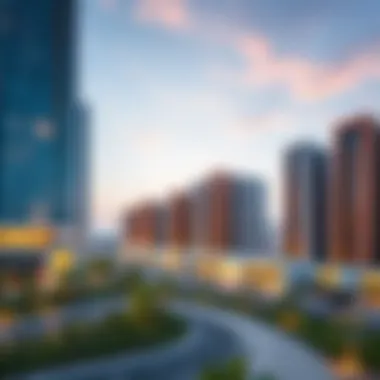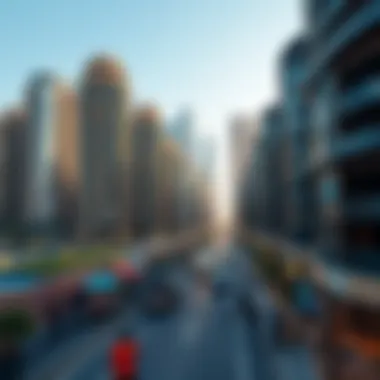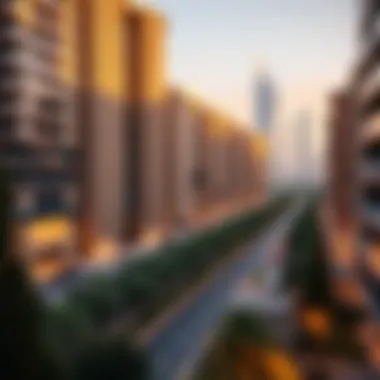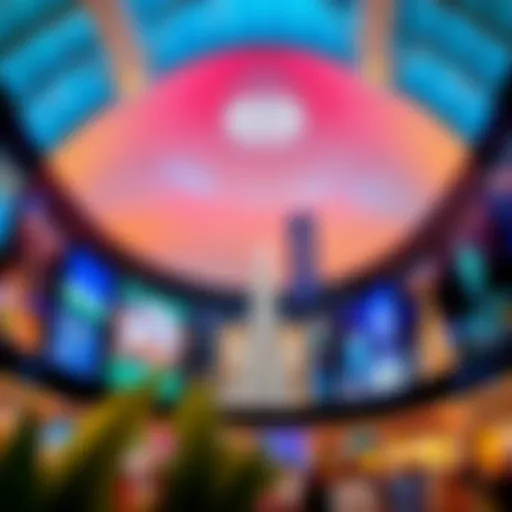Exploring Harmony 3 Master Plan for Dubai's Future


Intro
Dubai's ever-evolving urban landscape is a reflection of global modernism and ambition. In recent years, this desert metropolis has transformed itself into a vibrant hub of innovation, commerce, and lifestyle. Among the developments shaping this horizon is the Harmony 3 Master Plan — an initiative poised to redefine the way residents and visitors experience this remarkable city.
Through a blend of residential, commercial, and recreational spaces, the Harmony 3 Master Plan is not merely about buildings and roads. It's a carefully curated environment designed to foster community connections and promote sustainability. As we navigate through the intricacies of this comprehensive framework, we aim to shed light on its implications not only for the immediate real estate market but also for the broader community dynamics.
Investors, property developers, and real estate professionals are particularly keen on understanding what the Harmony 3 Master Plan means for their interests. The landscape of Dubai's real estate is fluid and ever-changing; thus, recognizing upcoming trends and investment opportunities becomes critical. This article seeks to offer a detailed exploration, laying out key components and implications that will guide stakeholders through this evolving journey.
By delving into market trends, identifying high-return areas, and spotlighting emerging neighborhoods within the grand design of Harmony 3, we aim to equip our readers with insights that drive informed decisions. Let's embark on this journey to uncover what promises to be a transformative chapter in Dubai's storied development.
Understanding the Harmony Concept
Understanding the Harmony 3 Master Plan is pivotal as it lays the very foundation of Dubai’s ambitious vision for urban development. This concept is not just a roadmap for city expansion; it merges various aspects of life, aiming for a harmonious balance among residential, commercial, and social spaces. Key factors like sustainability, community engagement, and infrastructure development ensure the plan addresses present needs while anticipating future challenges.
The essence of the Harmony 3 concept is its ability to navigate the complexities of urban life. By providing diverse living and working options, the plan stands to enhance quality of life for residents and promote economic growth for investors. Moreover, its focus on integrating green spaces and essential services into everyday living fosters a supportive atmosphere for community engagement, making it not just about building structures, but creating a vibrant lifestyle that attracts people from all walks of life.
Origins of the Harmony Plan
The Harmony 3 Plan finds its roots in Dubai’s transformative urban narrative, which began in the late 20th century. Originally a modest fishing village, Dubai evolved rapidly, driven by oil wealth and visionary leadership. However, the challenges accompanying this rapid urbanization—traffic congestion, housing shortages, and environmental degradation—necessitated a shift in approach. Enter the Harmony 3 framework.
This plan is inspired by global best practices while tailoring them to the local context of Dubai. Its inception involved consultations with stakeholders, ranging from local government to residents, ensuring that the plan reflects the diverse voices and needs of the community. The idea was to create a blueprint that is not only functional but also aspirational, connecting the past with the future as it embraces modernity.
Key Objectives of the Plan
The primary objectives of the Harmony 3 Plan revolve around creating an integrated urban environment that fosters livability, economic viability, and sustainability. Several key points emerge:
- Integration of Mixed-Use Developments: The plan promotes spaces that serve multiple purposes, allowing for residential areas to blend seamlessly with commercial zones, thereby reducing the need for long commutes.
- Community Well-Being: By prioritizing green spaces, recreational areas, and essential services, the plan aims to enhance the overall well-being of residents, making communities more vibrant and appealing.
- Sustainability Initiatives: The plan incorporates eco-friendly practices, ensuring energy efficiency and resource management are front and center in urban planning.
- Fostering Economic Growth: By attracting businesses and investment opportunities, the plan aims to generate jobs, driving economic growth and prosperity across the region.
In summary, understanding the Harmony 3 concept allows stakeholders to appreciate the thoughtful, multifaceted approach behind it. This isn’t merely about creating new buildings; it’s a vision designed to foster a holistic urban ecosystem that can sustain and thrive into the future.
Core Components of the Harmony Master Plan
The Harmony 3 Master Plan stands as a crucial framework for Dubai, articulating a vision that integrates residential, commercial, and green spaces into a cohesive urban environment. Each component plays a significant role in shaping the future landscape of this vibrant city, making it imperative to understand these interconnected elements. By detailing core components, stakeholders—especially investors and developers—can better navigate opportunities and challenges presented by such an ambitious project.
Residential Development Aspects
Types of Residential Units
The diversity of Types of Residential Units within Harmony 3 is a standout feature. Options range from high-rise apartments to more spacious villas. Each category appeals to different demographics, ensuring inclusivity in housing options. This segmentation not only meets varied lifestyle needs but also fosters a dynamic community feel. Additionally, these units often incorporate smart technologies that improve energy efficiency and enhance convenience, making them an attractive choice for modern residents.
- Key Characteristics:
- A mix of luxury, mid-range, and affordable housing that caters to both locals and expatriates.
- Integration of smart home features to enhance living experiences.
The unique aspect of these residential properties is their thoughtful design, which promotes community interaction while providing privacy for families.
Design Philosophy
The Design Philosophy of Harmony 3 is grounded in cultural reflection and sustainability. Architects have aimed to blend modern aesthetics with traditional Emirati elements, establishing a unique visual identity for the area. This philosophy affects not just the appearance of buildings but also their functionality, enhancing livability while respecting the culture.
- Key Characteristics:
- A focus on open layouts that encourage natural light and airflow.
- Use of local materials and designs that resonate with Dubai's heritage.
While bringing these elements together is beneficial in creating a strong sense of place, it can also pose challenges in terms of maintaining consistent construction quality.
Affordability Considerations
Affordability Considerations are paramount in shaping the residential landscape of Harmony 3. The plan aims to offer a variety of housing options that cater to various income levels. This commitment is essential for fostering an economically diverse community.
- Key Characteristics:
- Offering subsidized housing programs to make homeownership accessible.
- Collaboration with financial institutions to provide favorable mortgage conditions for buyers.
A standout element is the emphasis on creating community hubs that promote interaction among residents, contributing to a vibrant neighborhood atmosphere. However, balancing quality and affordability can be tricky and must be approached meticulously.
Commercial Zones and Opportunities
Commercial Structures Overview


The Commercial Structures Overview highlights a robust approach to integrating business opportunities within the Harmony 3 framework. This aspect is vital for stimulating economic growth and job creation.
- Key Characteristics:
- A crafted design that incorporates spaces for startups, retail, and larger enterprises, ensuring a varied commercial ecosystem.
- Strategic location to facilitate easy access for customers and suppliers alike.
Notably, the layout encourages pedestrian movement and engagement with the local environment, although it requires ongoing management to avoid overcrowding in busy areas.
Business Incentives
The Business Incentives in Harmony 3 aim to attract entrepreneurs and established companies alike, creating a flourishing commercial landscape. This can be seen as a significant draw for potential investors.
- Key Characteristics:
- Tax incentives and reduced leasing costs for businesses that prioritize sustainability and innovation.
- Collaborations with local authorities to streamline the process of obtaining commercial licenses.
While these incentives present lucrative opportunities, businesses must remain vigilant about maintaining compliance with evolving regulations.
Market Analysis
Conducting a thorough Market Analysis is crucial for understanding the commercial potential of Harmony 3. Key factors to consider include demographics, economic trends, and consumer behavior.
- Key Characteristics:
- Continuous evaluation of supply and demand dynamics in various sectors.
- Identification of emerging sectors and adapting commercial spaces to fit those niches.
The analysis not only serves to inform investors but can also assist in anticipating market fluctuations and adjusting strategies accordingly.
Incorporation of Green Spaces
Types of Green Spaces
The integration of Types of Green Spaces is essential for ensuring a balanced urban ecology within Harmony 3. From parks and gardens to green rooftops, these areas provide much-needed respite in bustling urban settings.
- Key Characteristics:
- Diverse ecological landscape featuring both native and exotic plant species to enhance aesthetics and biodiversity.
- Spaces specifically designed for recreation and relaxation, contributing positively to residents' quality of life.
Such green spaces not only beautify the area but also play a role in improving air quality, though maintenance and management could sometimes be challenging in urban contexts.
Environmental Considerations
Environmental Considerations in the Harmony 3 plan emphasize sustainable practices to minimize ecological footprints. Initiatives focus on efficient waste management and energy conservation.
- Key Characteristics:
- Implementing renewable energy sources like solar panels across public facilities and structures.
- Promoting sustainable water use practices throughout the development.
While adopting these measures is beneficial for the environment, they do require initial investment and long-term commitment from all stakeholders involved.
Benefits to Community Health
The incorporation of green spaces shows profound Benefits to Community Health, addressing both physical and mental well-being.
- Key Characteristics:
- Designated areas that promote physical activities, such as walking paths and sports facilities.
- Spaces aimed at fostering mental health, designed with tranquility and natural scenery in mind.
Encouraging outdoor activities benefits both individual health and social cohesion, enhancing community bonding while potentially reducing healthcare costs. Yet, it’s critical to offer adequate safety and maintenance to ensure these spaces are welcoming.
Transport and Infrastructure Planning
Integration with Existing Systems
Integration with Existing Systems within Harmony 3 is fundamental to maximizing transport efficacy. Establishing connections to current transport networks can streamline accessibility and operational efficiency.
- Key Characteristics:
- Strategic placement of bus and metro stations to ensure comprehensive transit options for residents and visitors.
- Coordinated routes that blend traditional transport with innovative solutions like smart transport systems.


While this seamless integration can facilitate flow, unpredicted congestion issues may arise that need to be addressed promptly.
Future Transportation Innovations
Focusing on Future Transportation Innovations within Harmony 3 sets the stage for a forward-thinking approach to urban mobility. This might incorporate autonomous vehicles, electric public transport options, and integrated bicycle lanes.
- Key Characteristics:
- Aiming for a significant reduction in traffic congestion and emissions.
- Offering incentives for residents to utilize eco-friendly transport options.
The challenge remains in ensuring user adoption of these new systems while also considering technological investments.
Civic Accessibility Measures
Civic Accessibility Measures are pivotal to guaranteeing all community members can participate fully in the social and economic life of Harmony 3. This involves designing infrastructure that meets diverse needs.
- Key Characteristics:
- Adapting structures and transport systems for individuals with disabilities.
- Ensuring pedestrian-friendly environments that prioritize safety and comfort.
Careful implementation balances accessibility with architectural aesthetics, a compelling challenge in urban planning that must not be overlooked.
Innovative Design Elements in Harmony
The Innovative Design Elements integrated within the Harmony 3 Master Plan play a pivotal role in reshaping Dubai's urban fabric. These elements are not just about aesthetics; they represent a cultural narrative that resonates with the community while prioritizing sustainability and functionality. Ultimately, this approach enhances the quality of life for residents and sets a benchmark for future urban developments.
Architecture that Reflects Culture
In the pursuit of a modernized city, the Harmony 3 Plan seeks to create architecture that echoes the rich heritage of Dubai. Each structure is designed to reflect local traditions while embracing modern technologies. This harmonious blend of old and new allows the urban landscape to celebrate its roots while catering to contemporary needs.
For instance, the use of traditional Arabic motifs in public spaces, coupled with sleek modern lines in residential areas, serves to create an environment that fosters cultural engagement. This architectural philosophy invites residents to connect with their history while also enjoying the benefits of modern living. Besides aesthetics, cultural architecture can significantly enhance tourism, further contributing to Dubai’s status as a global city.
Sustainable Design Practices
Sustainable design is a cornerstone of Harmony 3, ensuring that environmental impacts are minimized while promoting green living. This commitment is evident in two critical sub-elements: Energy-Efficient Technologies and Water Management Systems.
Energy-Efficient Technologies
Energy-efficient technologies are critical in reducing the overall carbon footprint of urban developments. These technologies include smart grid systems that facilitate better energy management through automation and optimization of energy consumption. The special characteristic of these systems is their integration of renewable energy sources, like solar panels, which can significantly cut down electrical costs for residents.
The unique feature lies in their ability to adapt to real-time energy demands, allowing buildings to operate efficiently, even during peak usage hours. This becomes a powerful selling point for investors and buyers as homes equipped with these technologies not only promise lower utility bills but also contribute to a greener planet. However, there may be initial costs associated with implementation, which could be perceived as a disadvantage for some. Yet, the long-term savings and positive environmental impact make them a compelling choice for future developments.
Water Management Systems
Water management systems form another vital aspect of sustainable design, enabling efficient usage and conservation of this precious resource. These systems are designed to recycle wastewater for irrigation purposes and offer advanced filtration technologies that improve water quality. A key distinguishing characteristic of these systems is their incorporation of smart technologies, which provide real-time monitoring of water usage and leak detection.
Such features present numerous advantages, including ensuring reliable water supply, especially crucial in a region prone to water scarcity. While the adoption of these systems can require substantial upfront investments, the long-term benefits – both financially and environmentally – offer a significant return. Residents can enjoy sustainably supplied water, enhancing their living experience while simultaneously contributing to community-wide efforts toward water conservation.
"Sustainable design practices in the Harmony 3 Master Plan symbolize a commitment to future generations, striking a balance between modern necessities and environmental stewardship."
In summary, the innovative design elements of Harmony 3 are thoughtfully crafted to meet the needs of a modern urban population while paying homage to local culture. These design philosophies not only enhance the livability of Dubai but also serve a greater ecological responsibility, ensuring a sustainable future for all who call this city home. By marrying architectural beauty with technology, Harmony 3 sets itself apart as a model for future urban endeavors.
Economic Implications of the Harmony Master Plan
The economic implications of the Harmony 3 Master Plan represent a crucial layer in assessing its overall significance. This initiative is more than an outline of architectural designs and green spaces; it encapsulates a holistic approach to urban living and presents several economic opportunities. With rapidly evolving dynamics, understanding the economic footprint becomes essential for investors, property buyers, and stakeholders in Dubai.
Impact on Real Estate Market
Price Trends and Projections
The pricing landscape in the Harmony 3 development is already showing ripples of upward momentum. As demand surges due to the project's comprehensive community design, home prices are anticipated to stabilize in the mid to long term. An intriguing characteristic of the price trends here is that it reflects both luxury and affordability, catering to a diverse range of potential homebuyers. As a beneficial choice in the ever-competitive market, the affordability aspect can draw in middle-income families alongside more affluent buyers, thereby expanding the demographic reach significantly.
A unique feature of this pricing trend is its connection to the overall economic conditions of Dubai. Economic stability can often lead to higher prices, which in turn can create a cycle—investors are likely to become more optimistic as property values rise, creating more demand. While some might label this a disadvantage due to the risk of potential overvaluation, the strategic planning of Harmony 3 intends to counteract such pitfalls through careful market research and adaptive pricing strategies.
Investor Sentiment
When dissecting investor sentiment, it’s evident that the Harmony 3 Master Plan has the potential to rally significant investor interest. The key characteristic driving this sentiment is the optimistic outlook tied to Dubai's robust economic recovery. A favorable investment climate, paired with government support, undoubtedly contrasts the economic uncertainties experienced globally. This context makes it an attractive prospect, both for seasoned investors and newcomers alike, eager to capitalize on a promising market.
Moreover, the unique feature of heightened investor confidence is underscored by how past developments in Dubai have flourished with similar master plans. The possibilities of capital gains seem to sway investors heavily; this could enhance the project’s initial success and encourage further urban innovations. Nevertheless, investors must consider potential fluctuations in market demand, which could suggest vulnerability if market enthusiasm wanes.


Job Creation through Development
The development initiated by the Harmony 3 Master Plan stands to contribute substantially to job creation, a vital metric often overlooked amid grand planning. This initiative forecasts thousands of job opportunities across diverse sectors, from construction to retail and beyond. Not only does this endeavor underscore the local government's ambitions to boost the economy, but it also aligns seamlessly with larger goals of sustainable development.
As the construction phases progress, immediate job opportunities emerge within various skill levels, providing avenues for many in the job market. Simultaneously, the operational phase, once establishments are completed, promises continued workforce demand, particularly in service-oriented roles.
"Increasing employment opportunities remains pivotal not just for the completion of the project but also for establishing a thriving community that sustains itself economically."
The economic implications of the Harmony 3 Master Plan weave a narrative filled with potential, carving pathways for both residential stability and investor interest. As Dubai continues to evolve, the success of such urban initiatives could set benchmarks for future developments, assuring stakeholders that the economic foresight within the Harmony 3 framework is not just a pipe dream.
Community Engagement and Stakeholder Involvement
The Harmony 3 Master Plan is not just a top-down initiative; it also places significant emphasis on community engagement and stakeholder involvement. This approach is instrumental in ensuring that the development aligns with the expectations and needs of those who will be impacted the most—residents, local businesses, and surrounding communities. By actively involving various stakeholders, the plan aims to create a more inclusive urban environment, enhancing the efficacy of the development while fostering a sense of ownership among the residents.
Importance of Community Engagement
Involving the community in the planning process brings numerous benefits. Firstly, it helps in gathering local insights that can guide anticipated developments. Residents often have firsthand knowledge of the area’s needs and can offer unique perspectives that experienced planners might overlook. Furthermore, engaging with the community builds trust and mutual respect between stakeholders and planners. People are more likely to support initiatives they’ve had a hand in shaping, which can lead to increased participation and better outcomes for all involved.
A well-executed community engagement strategy typically includes several phases. These can range from information sessions to workshops and surveys. Each phase contributes to a comprehensive understanding of local sentiments, building a foundation for effective dialogue and collaboration.
"Community participation not only shapes plans but transforms futures."
Consultation with Local Residents
When it comes to consulting with local residents, the process should be both systematic and sensitive. It’s essential to reach out through various channels, ensuring that everyone—from quiet neighborhood voices to more vocal groups—has an opportunity to weigh in. Often, this could mean organizing public meetings, setting up online forums, or even installing suggestion boxes in community centers. Communication should be clear, explaining how residents’ input could affect decisions regarding parks, amenities, and residential zones.
Apart from direct consultation, utilizing tools like community surveys can provide valuable quantitative data on public opinions and preferences. Effective consultation results in actionable insights that can directly influence zoning laws, resource allocations, and development timelines. Engaging with residents helps in building a community consensus around the vision for their neighborhoods, which can significantly enhance the sense of community ownership.
Role of Developers and Investors
Developers and investors play a crucial role in the overall success of the Harmony 3 Master Plan. Their engagement extends beyond financial investment; they help in shaping the community fabric through the design and execution of projects. Successful developers realize that fostering a good relationship with local communities can lead to smoother project implementation and ultimately higher returns on investment.
- Transparent Communication: Developers should aim for clear, honest communication about the types of projects being undertaken, timelines, and potential impacts on local residents. Town halls or forums can facilitate two-way dialogue, allowing developers to address concerns and answer questions.
- Incentives for Community-Centric Designs: Investing in community-centered designs can improve the environment of the locality. Developers should consider incorporating public spaces that promote social interaction, such as parks and community centers. This not only beautifies the area but can also significantly elevate property values.
Partnerships between local authorities, developers, and residents can result in tailored developments that reflect community needs while also meeting investors’ objectives. In this way, the Harmony 3 Master Plan can establish a vibrant urban atmosphere that balances commercial interests with local culture and communal well-being.
Understanding these dynamics is essential for anyone involved in Dubai's evolving urban landscape. By prioritizing community engagement and active participation, the Harmony 3 Master Plan can achieve its goal of creating a sustainable and flourishing environment for everyone.
Challenges and Critiques of the Plan
The Harmony 3 Master Plan, while touted as a transformative vision for Dubai, poses several challenges and critiques that merit careful examination. Understanding these obstacles not only aids stakeholders in making informed decisions but also contributes to refining the plan for more sustainable and efficient outcomes. Various aspects demand scrutiny, including feasibility concerns and potential environmental impact, both crucial in shaping public perception and investor confidence.
Feasibility Concerns
Feasibility is often the touchstone of any urban development plan, and Harmony 3 is no different. One might wonder whether the projected outcomes align with the financial and structural capacities of the city. Investors, agents, and potential buyers need assurance that the projects outlined in this master plan can indeed go from paper to reality without a hitch.
- Financial Viability: Questions around funding pose significant barriers. The complexity of financing such a grand initiative must be scrutinized. Looking into partnerships with private entities or considering public-private ventures might be approach that stakeholders find relevant.
- Timeline Realities: Often, grand plans on paper carry optimistic timelines. It's essential to consider if current market conditions, including labor availability and material costs, allow adherence to the timeline set forth in Harmony 3.
- Public Transportation Additions: Assessing the integration of proposed public transport systems into existing infrastructure is vital. Any discrepancies here can lead to increased costs and prolonged delays, which could undermine investor trust.
"The success of an urban master plan hinges not just on visions but on its ability to manifest in layers of reality — from sketch to brick."
In essence, outlining a roadmap guiding the various phases of development could provide insights into potential delays or shifts in strategy that are essential for stakeholder confidence.
Potential Environmental Impact
The environmental ramifications of urban development plans cannot be overstated, especially in a region where desert landscapes meet rapid urbanization. The Harmony 3 Master Plan includes aspirations for incorporating green spaces, however, the potential environmental impact still raises eyebrows.
- Resource Management: Water conservation will be pivotal. Given Dubai's arid climate, the need for sustainable water resources can't be a mere afterthought. Critics argue that without a robust plan for water recycling and conservation, the project may overburden local aquifers.
- Biodiversity Preservation: Concerns regarding the disruption of local flora and fauna are significant. As developers cut through natural landscapes for urban sprawl, the impact on existing ecosystems could be dire. It may be important to strategize around minimizing habitat destruction while enhancing green areas effectively.
- Climate Resilience: Another layer of scrutiny involves evaluating how well the plan accommodates climate change realities. Rising temperatures and changing weather patterns should influence design, infrastructure, and planning strategies. The absence of adaptive strategies could render the project less viable in the not-so-distant future.
In navigating these complexities, addressing feasibility and environmental concerns will not only enhance the credibility of the Harmony 3 Master Plan but also ensure it paves a path toward a more sustainable urban landscape in Dubai.
Future Outlook: The Path Ahead for Harmony
The Harmony 3 Master Plan stands as a monumental initiative in the rapidly evolving urban landscape of Dubai. Understanding the future outlook of this plan is crucial, as it reveals both the potential benefits and the challenges that lie ahead. This perspective offers a roadmap not only for stakeholders but also for residents whose lives will be intricately intertwined with the developments.
Timeline for Development
A clear timeline is essential for any large-scale project like Harmony 3. This timeline dictates not just the pace of construction but also the strategic milestones that need to be achieved along the way. Currently, the plan outlines several significant phases:
- Initial Planning and Cost Assessment: This phase has largely been completed, ensuring that the financial framework and urban design concepts have been thoroughly vetted. It took roughly about 18 months to finalize this critical groundwork.
- Infrastructure Development: Expected to kick off in early 2024, this phase primarily focuses on roads, utilities, and essential services. The completion of this stage is pivotal, as it sets the foundation for subsequent residential and commercial constructions.
- Residential and Commercial Construction: Targeted to commence by late 2025, this stage will see the erection of residential units alongside commercial spaces. Given the projected demand in Dubai’s real estate market, it is anticipated that this segment will proceed at a rapid pace.
- Finalization and Occupancy: The grand opening is planned for mid-2028, coinciding with major cultural and economic events in Dubai, which will undoubtedly elevate its profile.
This timeline is not set in stone. It could easily shift depending on various factors like economic conditions, global events, and community feedback. Stakeholders need to remain flexible and engaged through every stage to adapt as necessary.
Long-term Urban Planning Vision
The long-term vision surrounding the Harmony 3 Master Plan transcends mere construction; it embodies an entire urban philosophy. The plan aspires to weave residential life seamlessly with commercial activity and nature, creating a balanced ecosystem.
- Sustainable Development Principles: A core tenet of the long-term vision is a commitment to sustainability. This includes energy-efficient buildings, green spaces, and efficient public transport systems that reduce reliance on cars.
- Community-Centric Model: The vision emphasizes creating spaces that foster community interaction. Rather than isolated developments, residents will encounter open green areas, parks, and community centers designed to encourage social engagement and inclusivity.
- Technological Integration: As cities increasingly adopt smart technologies, the Harmony 3 will likely incorporate cutting-edge innovations. This might involve smart energy grids, sophisticated traffic management systems, and the use of data analytics to enhance urban living.









